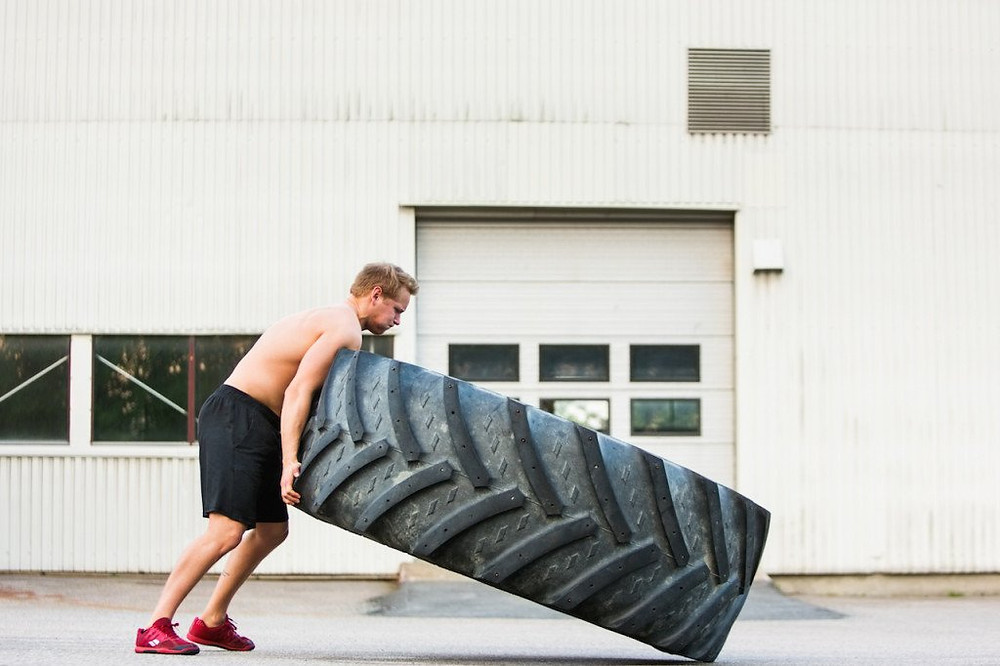Gone are the days when training was limited to the same old traditional gym equipment.
While originally used in strongman and strongwomen competitions, tires have become a staple in well–equipped gyms throughout the world.
They allow for a unique kind of strength and conditioning training that readily transfers to a variety of sports.
This article lays out the best tire exercises, the muscles they work, and a sample tire circuit to get you started.
The key to performing tire exercises is selecting a tire of the right size and weight to meet your level of strength and experience, as well as to avoid injury.
Start with a smaller, lighter tire and work your way up to a larger, heavier tire as you progress in strength and skill. It’s recommended that women begin with a tire that weighs 100–200 pounds (45–90 kg), while men are recommended to start with a 200–300-pound (90–135-kg) tire.
As a rule of thumb, you should be able to do 2–5 repetitions of the exercises below with consistency. If you can’t, the tire is probably too heavy.
Estimating the weight of a tire is not an exact science. Still, there are some averages, according to size (1, 2).
| Tire size | Average tire weight |
| Car tire | 25 pounds (11 kg) |
| Commercial truck tire | 100–200 pounds (about 45–91 kg) |
| 17.5 x 25 foot tractor tire | 300 pounds (136 kg), maximum |
| 20.5 x 25 foot tractor tire | 400–500 pounds (181–227 kg) |
| 23.5 x 25 foot tractor tire | 400–800 pounds (181– 363 kg) |
| 26.5 x 25 foot tractor tire | 1,000 pounds (454 kg) |
It can be tricky to know how much a tire weighs because it’s difficult to put a large tractor tile on a scale. If you’re hauling it by truck, you can drive to a CAT scale, measure the weight of your truck with the tire, and then subtract the weight of your truck to find the weight of the tire.
Some specialized tires allow weights to be added or removed, making the process of adding resistance a bit easier.
SummaryTires can be hard to weigh, and their weights are often estimated. Select a tire size that allows you to complete at least 2–5 reps consistently.
Tire availability varies depending upon where you live.
Those in rural areas may find it easier to find old tires from agricultural equipment, which also tends to be the most cost-effective source.
You may want to check local online classified ads for listings of people selling used tires, as larger new tires tend to be quite expensive.
While car tires can work for some exercises, you’ll want a slightly larger tire to best perform most movements, especially as your strength and skill increase.
Fortunately, many gyms now have an outdoor or indoor turf area with access to tires.
SummaryThe tire flipTires are best found by searching local online classified ads or contacting a farm that has agricultural equipment.
Also, many gyms now have a turf area with tires of various sizes for members to use.
The tire flip is a classic tire exercise that enhances explosive power development from head to toe.
The key to this exercise is selecting the right tire size and weight to meet your level of strength and experience, as well as to avoid injury.
Muscles worked: glutes, hamstrings, quads, calves, lats, traps, biceps, triceps, forearms, abs (to stabilize)

The tire deadlift with farmer’s walk is a unique tire exercise that provides all of the benefits of a traditional deadlift movement with an added conditioning aspect.
This movement requires excellent core and grip strength to stabilize the tire during the farmer’s walk portion of the exercise.
Muscles worked: glutes, hamstrings, quads, lats, traps, biceps, forearms, abs

This movement can also be performed without the farmer’s walk portion as a deadlift only for a designated amount of sets and reps.
Tire slamsThe tire slam is an excellent movement for developing upper-body power and endurance through various planes of motion.
This exercise requires a sledgehammer or mace as a training device with which to strike the tire.
You’ll want to use a tire that’s large enough to absorb the shock of the impact without moving around too much.
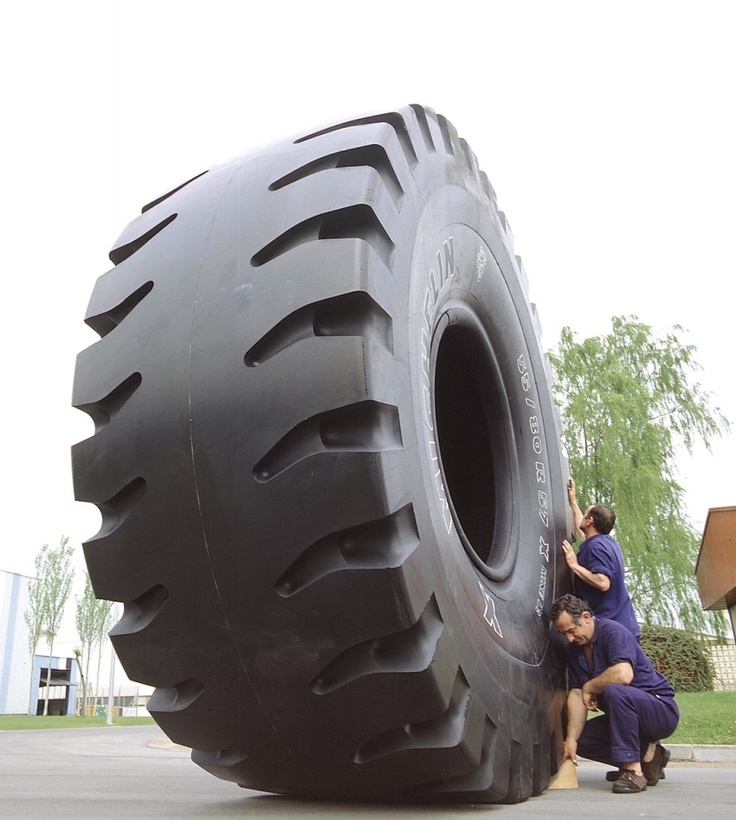
The tire slam can be performed in timed intervals, during which you strike the tire for a designated amount of time, or in sets, during which you perform a given number of reps or strikes.
Tire broad jump with tire flipThis is a dynamic exercise that combines two popular tire exercises to maximize your training adaptations.
For this exercise, it’s best to select a lighter tire that you can comfortably jump over repeatedly.
Muscles worked: quads, hamstrings, glutes, calves, lats, traps, biceps, forearms, abs

Box jumps are a common plyometric exercise in which your muscles exert maximal force for a brief period of time.
In this variation, a tire is used instead of a box, providing an added layer of difficulty, as you’ll need to stabilize yourself on the landing due to the flex of the tire.
Select a tire of an appropriate height for your skill level.
Two tires can be stacked on top of one another as you become more advanced.
Muscles worked: quads, hamstrings, glutes, calves, abs
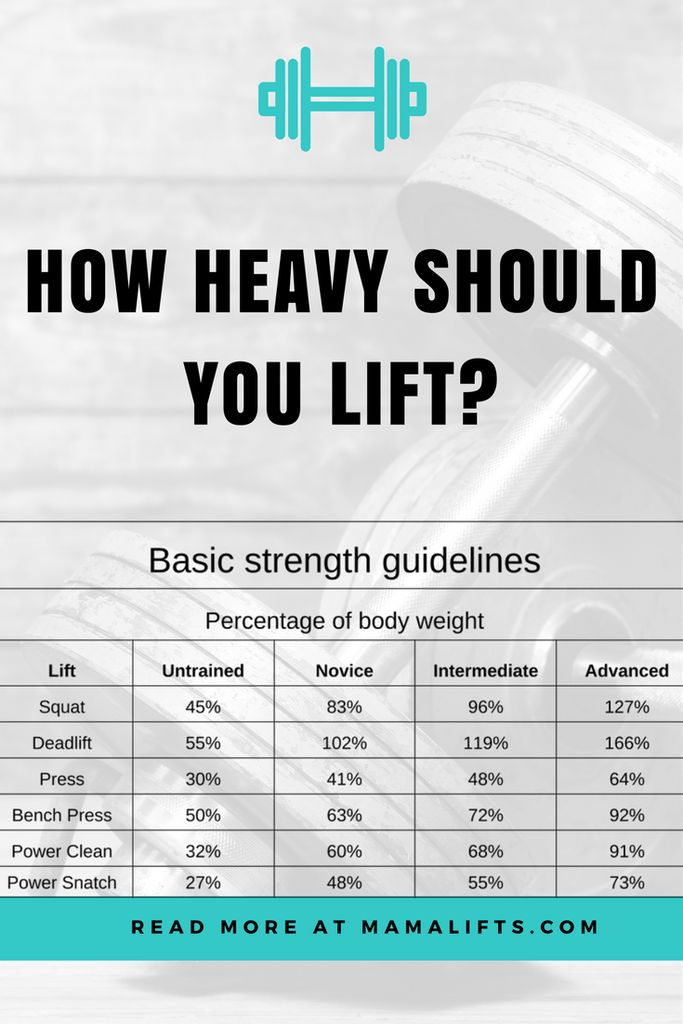
Tire pushups are a versatile upper-body exercise that can be adjusted for your desired level of difficulty.
Beginners should perform torso-elevated pushups, which will decrease the resistance, whereas more advanced trainees may want to try leg–elevated pushups to crank up the resistance.
Muscles worked: pecs (chest muscles), anterior delts, triceps, abs
Torso-elevated pushups (easier)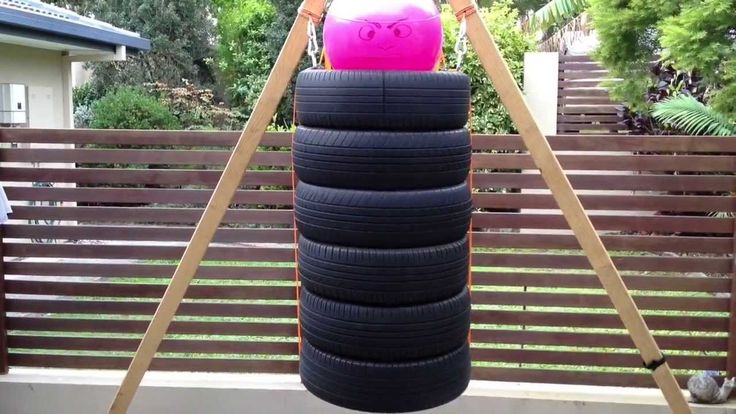
Planks are a challenging exercise that targets your abdominal muscles.
In this variation, you’ll use a tire to increase or decrease the difficulty level.
To make the exercise slightly easier, you’ll perform an incline plank, or if you want to kick things up a notch, you can perform a decline plank.
Muscles worked: abs, obliques (side abs), lower back
Incline plank (easier)
Tire dips are a fantastic exercise for isolating the triceps, as well as a great addition to any well–rounded tire circuit.
For this movement, you’ll want to use a tire large enough to support your body weight without tipping over.
Muscles worked: triceps, pecs, shoulders
The tire squat and press is a dynamic exercise that targets multiple muscle groups simultaneously.
Muscles worked: quads, hamstrings, glutes, triceps, shoulders, chest, abs
This high intensity tire movement will be sure to get your heart pumping.
Side-to-side hops provide excellent conditioning while hitting several major muscle groups.
Muscles worked: quads, hamstrings, glutes, shoulders, chest, triceps, abs
A tire circuit strategically combines a series of tire exercises to provide a high intensity, full-body workout.
The goal during a tire circuit is to keep your heart rate elevated by performing movements back to back with only brief periods of rest in between.
Tire circuits can be performed as a training session on their own or added to a strength training program as additional conditioning work.
Here’s a sample tire circuit to get you started, incorporating the above movements.
Start with a 5–10-minute warmup to get your blood flowing and joints loosened up. Some suggested warmup methods include jumping rope or hitting the treadmill, elliptical, or spinning bike.
Follow this with some dynamic stretches to prime your joints for the high intensity movements to come.
This tire circuit is not for beginners. You’ll want to make sure you can perform each of the movements individually before attempting the circuit.
If you’re using a heavy tire, start with a total of 10 reps maximum of each exercise. That can be accomplished with 2 sets of 5, or 3 sets of 3. If you’re using a lighter tire, you can do 3–4 sets with 6–10 reps each.
Feel free to swap out a movement if you’re unable to perform it. Always begin your workouts with more complex, compound exercises.
The main eventAfter an intense workout like a tire circuit, static stretching can help your muscles recover more quickly, reduce muscle soreness, and improve flexibility (3, 4).
Perform some general stretches to boost the recovery process and cool down after your workout.
SummaryThis intense tire circuit will put together all of the exercises previously introduced to give you a full-body workout that promotes both strength and conditioning.
Tire exercises are unique in that they provide a muscle stimulus unlike most other movements.
Completing tire exercises regularly comes with several potential benefits.
Multiple planes of movementThere are three planes of movement you move in during daily activities and exercise. These include frontal (side to side), sagittal (front to back), and transverse (rotational movement).
Many traditional exercises only work in one plane of movement, whereas most tire exercises utilize multiple planes of movement simultaneously.
This makes tire exercises transfer more efficiently to various sports, which also require you to move in multiple planes of motion.
Therefore, athletes training for their given sport may benefit from incorporating tire exercises into their exercise regimen.
Another notable benefit of tire exercises is their ability to provide both strength and conditioning training simultaneously.
Strength training, also known as resistance training, refers to moving your muscles against an external resistance as a means to increase muscle mass, metabolic rate, and bone mass, as well as prevent injuries (5).
Conditioning, on the other hand, refers to performing high intensity movements specific to your sport that improve aerobic endurance, speed, skill, agility, and balance.
Most tire exercises tick both boxes, providing enough resistance to improve strength, while also providing high intensity movements that enhance conditioning applicable to a wide variety of sports.
That said, other methods of weight training should also be incorporated into your training program to maximize muscle and strength gains (6).
Power, or the ability to rapidly create maximal force, is an important aspect of athletic training.
Research suggests that power development is best trained with explosive movements at 30–50% of your one-repetition maximum (1RM), or the amount of weight you can lift for one rep of a given movement (7).
Many tire exercises fit this category, making them excellent for training power development.
To further enhance the power-developing effects of tire training, perform the movements explosively, providing maximal effort with each rep.
SummaryTire exercises provide a unique muscle stimulus that offers several benefits. These include providing movement through multiple planes, contributing to both strength and conditioning, and boosting power development.
While tires are an excellent tool to boost your exercise intensity, there are some precautions you should take to avoid getting injured.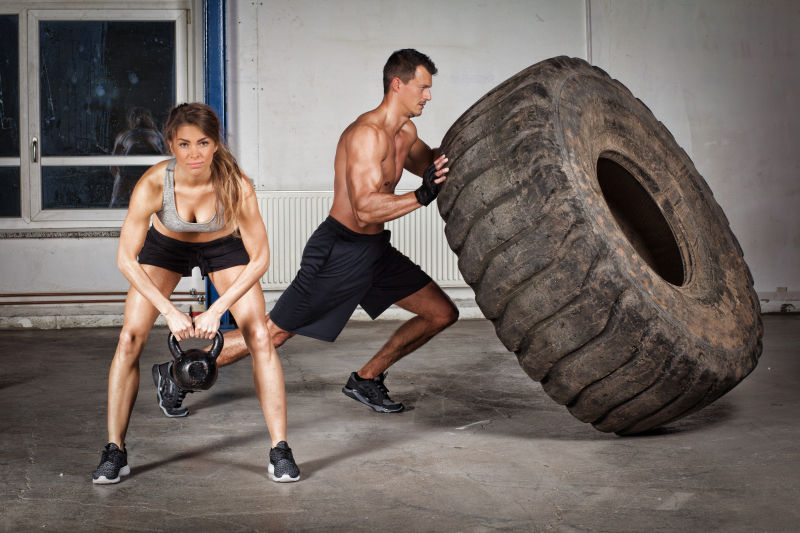
Tires can be awkward to work with, especially the larger ones, and tire workouts require a great deal of skill to perform properly. As such, it’s important to focus on good technique throughout the movements.
One of the most common tire–related injuries is a bicep tear (8).
These often occur during the lifting portion of the tire flip, during which the biceps are in a stretched and compromised position.
To avoid a bicep tear during the tire flip, make sure to press your shoulder into the tire at the bottom of the movement and use the stronger muscles of your posterior (glutes, hamstrings, back muscles) for momentum. Avoid lifting the tire solely with your arms.
Other common injury–prone areas include the lower or mid-back, shoulders, and knees (8).
The best way to avoid injuries from tire exercises is to choose the right size tire for your level of strength and experience.
Work with a partner when possible to help you manipulate the tire and prevent it from falling on you.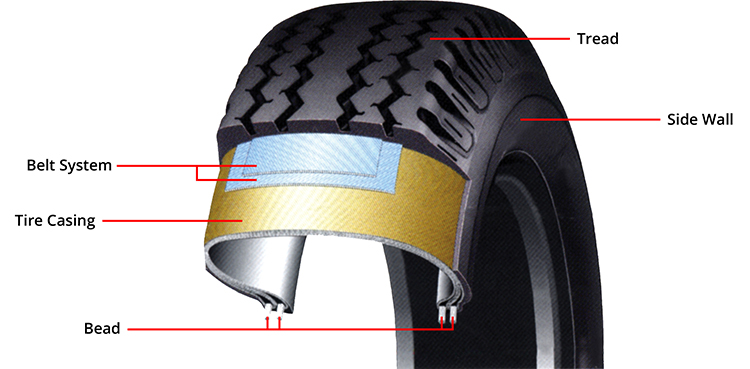
SummaryGiven the size and weight of large tires, there’s a risk of injury when completing tire exercises. Select the right size tire for your level of strength, and work with a partner when possible to best avoid injuries.
Tire exercises have emerged as a training strategy for athletes and recreational gym-goers alike.
They can be strategically combined to create a tire circuit that provides a well-balanced, full-body workout, hitting all of your major muscle groups.
Regularly performing tire training comes with several potential benefits, including providing movement through multiple planes, contributing to both strength and conditioning, and boosting power development.
Considering the large size and weight of many tires, they present a significant risk for various injuries. Therefore, it’s best to start with a lighter tire and gradually progress as you become stronger.
Whether you’re an athlete looking to improve your performance or a recreational gym-goer looking to improve your fitness, tire exercises may be an excellent addition to your training program.
Tire flips look tough and demand every ounce of strength you can muster. They're definitely not for everybody, but if you earn the right, your reward will be a new level of power and athleticism!
Name: Zach Even-Esh
Location: New Jersey
Occupation: Strength coach, owner of Underground Strength gym, author of "The Encyclopedia of Underground Strength Training,"
host of Strongcast podcast
Website: zacheven-esh.com
Back in 2002 or 2003, I was an aspiring strength coach with what seemed like a big problem. The "functional training" craze was in full force, and coaches talked endlessly about the Swiss ball, training on one leg, and performing cable chops on expensive cable machines. Some of them still do.
The "functional training" craze was in full force, and coaches talked endlessly about the Swiss ball, training on one leg, and performing cable chops on expensive cable machines. Some of them still do.
Over the previous few years, I had run up a fair amount of debt—about $26,000—and I saw no way to open a small training space with the most popular and expensive equipment. On the other hand, I also really didn't identify with the pretty training I saw on the Internet. I was attracted to raw, intense training, where location didn't matter, and being strong and tough was the primary aim.
I remembered driving by a tire yard in my old hometown countless times. The tires were enormous, and piles of them stretched past the fence that was locked up after hours. The thought of going in and doing battle against a huge tire, training like gladiators—that's what I connected with most.
One day, I wandered into the office to see if the guy in charge would let me and my buddy flip some tires on a Saturday morning—just to try it out. He seemed hesitant at first, but must have sensed my passion, and let us in.
He seemed hesitant at first, but must have sensed my passion, and let us in.
We met two of the workers in the middle of the tire yard. It was like an arena of sorts, full of nothing but concrete and tires. The first tire they pulled down on the forklift looked pretty damned big.
I volunteered to go first, and it took what seemed like a lifetime to flip that beast. I wrestled it up and finally pushed it over. It felt like a street fight, and I was crushed after that one rep. My buddy tried to flip the tire, with no luck, so we reluctantly asked the forklift operator to pull down a smaller tire.
Flipping tires is an activity that's worth your time, but even more than that, worth your respect.
This tire was 400 or 500 pounds, and we took turns flipping it for 10 or 15 minutes. The two tire-yard workers watched us as they smoked cigarettes. We hesitated to admit it, but pretty quickly, we were done. That's when the guys put down their cigarettes and said they'd finally show us how to flip tires.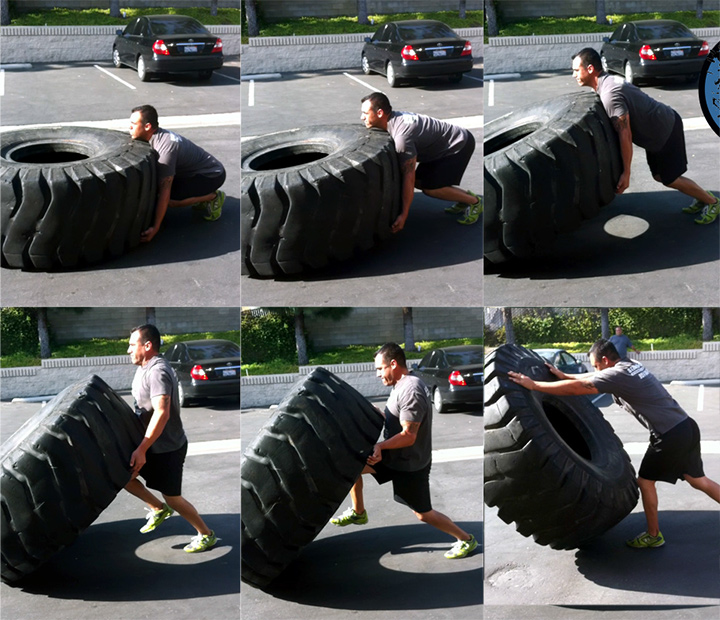
They tore through those tires with ease. Where my buddy and I struggled to manage 2-3 reps, these guys flipped the tire for 5 and 6 reps with ease. When they both finished, they laughed, looked at me and my buddy, and said one word: "Easy!"
I laughed, but deep down, I was embarrassed and angry—angry that my buddy and I looked strong and impressive by "normal" standards, but our ability to demonstrate that strength outside of the gym was subpar.
Since then, I've flipped a lot of tires, and I've taught a lot of people to do it as well. It's an activity that's worth your time, but even more than that, worth your respect. Here's where to start.
The tire flip has become a fad exercise, unfortunately. You see coaches allowing people to flip tires using rounded backs and poor technique. The tire flip is an exercise one must earn.
What does that mean? First, you need to get strong in all areas of your body. You can approach this a number of ways, but you definitely need to be proficient at these exercises:
Now, don't let that list lead you to believe that you deadlift the tire to flip it, or that you use your biceps to curl it up. Neither approach will generate enough power to get a decent-sized tire up on its side. As I discuss in the video, a tire isn't like other weights. You have to drive through it, not lift it.
Neither approach will generate enough power to get a decent-sized tire up on its side. As I discuss in the video, a tire isn't like other weights. You have to drive through it, not lift it.
Before you get excited and run outside to hunt down some rubber, understand that there are some dangers behind the tire flip. Your back and arms are at the greatest risk of injury, so keep these two tips in mind:
Are you strong enough? Is your form on the three movements I listed truly up to snuff? If the answer to both is yes—be honest!—let's talk details.
Tire flips are tough—and they should be tough. Let's be clear: Flips for high reps with a small or light tire are not an effective conditioning exercise. The small tire often causes people to perform a round-backed squat, and then they curl the tire up, which goes against the name of this exercise. It's a tire flip, not a tire curl. If you're looking for explosive conditioning, you're better off performing high-rep kettlebell swings.
It's a tire flip, not a tire curl. If you're looking for explosive conditioning, you're better off performing high-rep kettlebell swings.
That out of the way, if you're just starting out, stick to low reps with a light tire. Start with 5 sets of 2 reps, resting about a minute after each set. Focus on speed and technique.
For advanced trainees, make sure you are thoroughly warmed up before flipping a heavy tire.
For advanced trainees, make sure you are thoroughly warmed up before flipping a heavy tire. "A few sets of a few reps" is my motto. Aim for a total of 10 hard reps. You can break those reps down a number of ways:
If all you have is a lighter tire, still keep the reps low to prioritize speed and technique. At most, perform something like a 5 x 5 protocol.
The tire flip is a great exercise, but like any exercise, you must avoid overusing it. Cycle this exercise in and out of your program. If you're new to odd objects and strongman-style training, build your foundation with the three key exercises I listed above, in all their variations.
Cycle this exercise in and out of your program. If you're new to odd objects and strongman-style training, build your foundation with the three key exercises I listed above, in all their variations.
The tire flip is definitely best used early in a workout, after a thorough warm-up. View it as a max-effort exercise or a main lift, because it uses your legs and back primarily—and intensely. You don't want to try a tire flip after heavily fatiguing yourself with squats and deadlifts.
As for when not to use a tire flip, well, if you have any doubt in your strength or ability—either in general or as you're walking up to the tire itself—don't attempt the flip. If I haven't made it clear already, beginners have no business performing the tire flip.
This exercise requires both skill and a solid foundation of strength, which is why it has been a staple in strongman competitions for decades. Earn the right to flip the tire.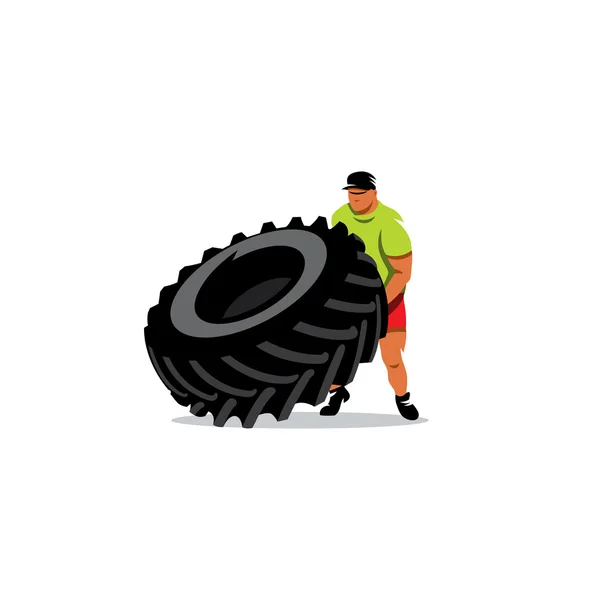 Then use it to help you transfer your strength into brutal full-body power!
Then use it to help you transfer your strength into brutal full-body power!
Zach's inspiration in training comes from the golden era of bodybuilding and the days of old-school strength. His mission is to help you kick ass!
View All Articles By This Author
0003Related materials
7 rubber signals: what the tire says about car problems
How do you know when tires are completely worn out and it's time to change them? Everything is simple. For summer tires, the limit is 1.6 mm of residual tread depth, and for winter (or all-season tires used in winter) - 4 mm. Modern summer tires can travel from 40,000 to 70,000 km, depending on driving style and vehicle characteristics. An average motorist rolls such a mileage on summer tires in 2-3 seasons.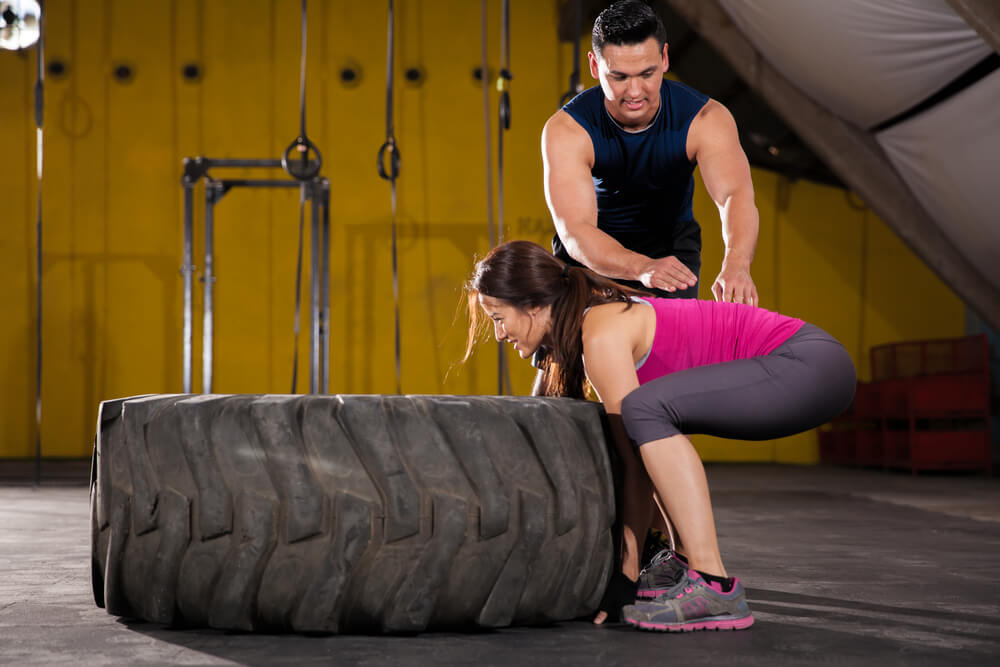 Moreover, wear implies not only a decrease in tread depth. For millions of cycles of deformation, the strength of the carcass and its adhesion to the layers of the rubber compound are violated. In short, every 2-3 years you should buy a new set of tires. nine0003
Moreover, wear implies not only a decrease in tread depth. For millions of cycles of deformation, the strength of the carcass and its adhesion to the layers of the rubber compound are violated. In short, every 2-3 years you should buy a new set of tires. nine0003
In case of irreparable damage to one of the tires and a relatively high total mileage of the kit, it is also worth considering replacing it. Well, or about buying at least a pair of new tires, which, for any type of drive, should be installed on the front axle. We put two tires back - the most decent of the remaining ones.
Many motorists drive only a few thousand kilometers a year. This does not mean that the tires will serve you for several decades. According to Russian requirements (GOST 4754-97), the service life of passenger car tires is 5 years from the date of manufacture. And for example, Continental recommends that all car tires (including the spare tire) older than 10 years old should be replaced with new ones. Therefore, with small runs, you can navigate for ten years. The date of manufacture of the tire is indicated on the sidewall. Usually it is an oval with four numbers. The first two are the ordinal number of the week in the year, the last two indicate the year.
Therefore, with small runs, you can navigate for ten years. The date of manufacture of the tire is indicated on the sidewall. Usually it is an oval with four numbers. The first two are the ordinal number of the week in the year, the last two indicate the year.
Related materials
How to change the car yourself - detailed instructions
Tires should be rotated periodically in accordance with the vehicle manufacturer's recommendations - information on this can be found in the owner's manual.
We can advise you to carefully use the tires and, most importantly, to store them correctly in the off-season. First of all, during storage, it is important to exclude direct sunlight from hitting the tires, which greatly age the rubber. Tires without rims should be placed vertically, and stacked on rims. nine0003
And before installing tires on a car at the beginning of the season, evaluate their condition. There should be no cracks in the tread and sidewalls. The tire should not be dry, it should remain rubbery and not look like baked plastic.
There should be no cracks in the tread and sidewalls. The tire should not be dry, it should remain rubbery and not look like baked plastic.
Related materials
Driving on badly worn tires - will I be fined or not?
Winter tires have a much shorter life span. They almost always fail due to the wear of the treadmill, because the tread of a new tire is 7–8 mm, and only 3–4 mm remain working height. If the tires are studded, then with such wear there are very few metal elements left, and the tire will not provide adequate safety when driving on a winter road. However, not only spikes, but also Velcro, with such a degree of wear, also lose most of their capabilities. nine0003
The real life of winter tires rarely exceeds 30,000 km. "Bald" winter tires without studs can be re-rolled in summer, but their grip on hot road surfaces will be very poor. This must be taken into account, especially when braking.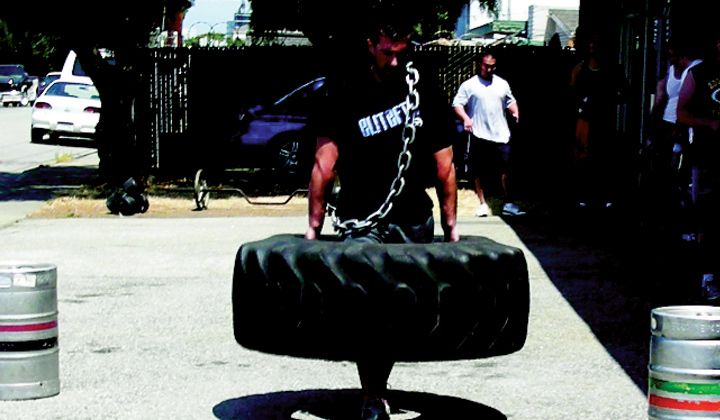
***
So: tires that have not yet worn out along the tread (that is, up to 1.6 mm tread depth for summer tires, 4 mm for winter tires) are changed either ten years after the date of issue, or when the rubber layer cracks tires or damage. nine0003
Our new video
Why do I choose a used Vesta, not a new grant: 5 arguments
The first test of the Chinese Dongfeng EC35 (video)
Niva and UAZs became the best gift for the fighters of
? Subscribe and you will always be in the know!
Driving in Zen
News smi2.ru
Tire manufacturers unanimously say that their requirements for the installation of branded wheels are an immutable law of the universe, the violation of which will inevitably lead to apocalyptic consequences.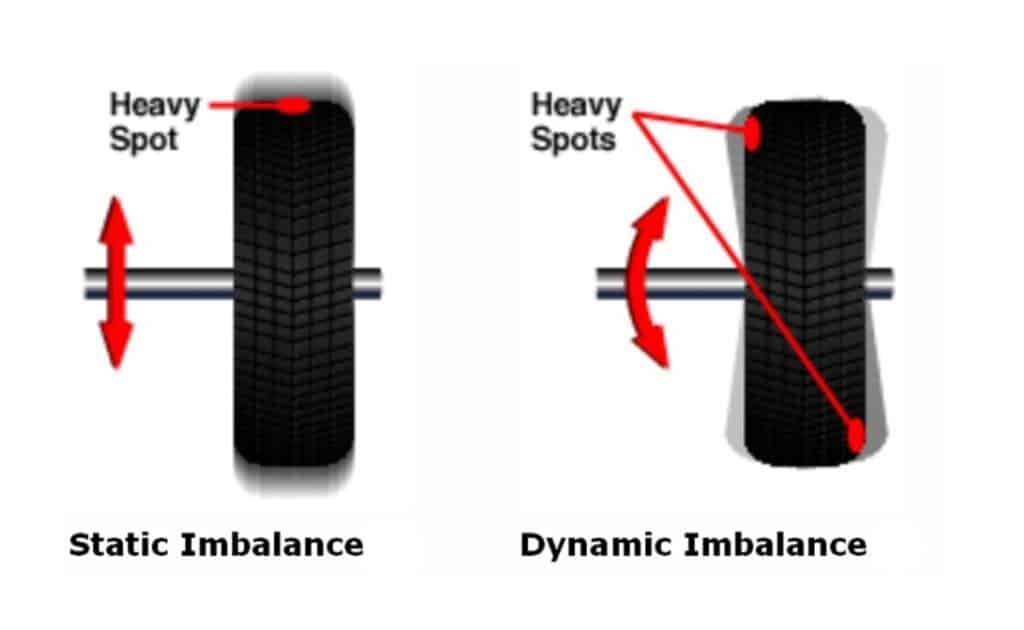 But is it really so bad, the AvtoVzglyad portal figured it out.
But is it really so bad, the AvtoVzglyad portal figured it out.
Maxim Stroker
As for the opinion of tire companies on this matter, everything is clear with their position: put the directional wheel “in the wrong direction” - blame yourself, if something happens. It’s also somehow not serious to rely on the opinions of participants in various Internet forums on this matter, to focus on the subjective rantings of complete strangers is a dubious occupation. nine0003
Finally, during a long search, we came across a study of a specialized European organization - the European Tire and Rim Technical Organization (ETRTO), whose name can be translated as "European Rim and Tire Technical Organization". They once took and checked how wheels with a directional tread pattern behave when they are installed on a car in the opposite direction of rotation from the manufacturer's recommended one.
The test report states that tires from three well-known brands took part in the test. Their behavior was studied under controlled wet road conditions, both in the case of correct installation on the car, and in the case of "reverse" installation. The specialists were interested in two main questions: how much the controllability of the car and its braking characteristics depend on the correct installation of directional rubber. nine0003
Their behavior was studied under controlled wet road conditions, both in the case of correct installation on the car, and in the case of "reverse" installation. The specialists were interested in two main questions: how much the controllability of the car and its braking characteristics depend on the correct installation of directional rubber. nine0003
The results of unbiased professionally organized tests, oddly enough, could not reveal significant changes in the wet grip coefficient of the wheels with different mounting options. Moreover, the absence of a noticeable negative effect with the “reverse” installation of a directional tire was typical for all tire brands that participated in the study. Thus, it can be argued that the handling and braking characteristics do not change with an error in wheel alignment.
The only thing that is really affected by the direction in which a directional wheel is mounted is hydroplaning. Or rather, the speed at which it starts. The car "with the wheels in the wrong direction" loses contact with the road at a slightly lower speedometer reading than in the case of correctly installed tires.